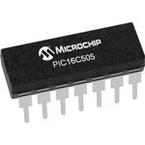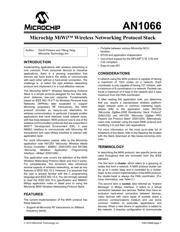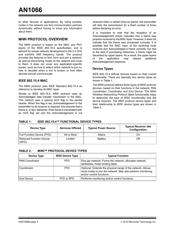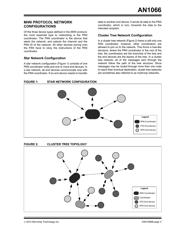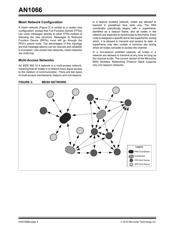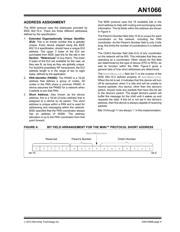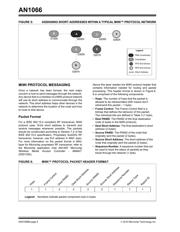下载

© 2010 Microchip Technology Inc. DS01066B-page 1
AN1066
INTRODUCTION
Implementing applications with wireless networking is
now common. From consumer devices to industrial
applications, there is a growing expectation that
devices will have built-in the ability to communicate
with each other without a hard-wired connection. The
challenge is to select the right wireless networking
protocol and implement it in a cost-effective manner.
The Microchip MiWi™ Wireless Networking Protocol
Stack is a simple protocol designed for low data rate,
short distance, low-cost networks. Fundamentally
based on IEEE 802.15.4™ for Wireless Personal Area
Networks (WPANs) later expanded to support
Microchip proprietary RF transceivers, the MiWi
protocol provides an easy-to-use alternative for
wireless communication. In particular, it targets smaller
applications that have relatively small network sizes,
with few hops between. MiWi protocol now is one of the
wireless communication protocols that are supported in
MiWi™ Development Environment (DE). It uses
MiMAC interface to communicate with Microchip RF
transceivers and uses MiApp interface to interact with
application layer.
For more information, please refer to the Microchip
application note AN1283 “Microchip Wireless Media
Access Controller - MiMAC” (DS01283) and AN1284
“Microchip Wireless Application Programming
Interface - MiApp” (DS01284).
This application note covers the definition of the MiWi
Wireless Networking Protocol Stack and how it works.
For completeness, this document also introduces
several aspects of wireless networking, as well as key
features of IEEE 802.15.4. However, it is assumed that
the user is already familiar with the C programming
language and IEEE 802.15.4. You are strongly advised
to read the IEEE 802.15.4 specification and MiMAC/
MiApp application notes in detail prior to using the
Microchip MiWi Wireless Networking Protocol Stack.
FEATURES
The current implementation of the MiWi protocol has
these features:
• Support all Microchip RF transceivers on different
frequency bands.
• Portable between various Microchip MCU
families.
• RTOS and application independent
• Out-of-box support for the MPLAB
®
C18, C30 and
C32 compilers
• Easy-to-use API
CONSIDERATIONS
A network using the MiWi protocol is capable of having
a maximum of 1024 nodes on a network. Each
coordinator is only capable of having 127 children, with
a maximum of 8 coordinators in a network. Packets can
travel a maximum of 4 hops in the network and 2 hops
maximum from the PAN coordinator.
If, after reading this application note, you determine
that you require a standardized wireless platform,
larger network sizes or common marketing logos,
please refer to the application notes AN1232
“Microchip ZigBee-2006 Residential Stack Protocol”
(DS01232) and AN1255 “Microchip ZigBee PRO
Feature Set Protocol Stack” (DS01255). Alternatively,
users may consider using the basic MiWi protocol and
modifying it to suit their own applications.
For more information on the most up-to-date list of
limitations of the Stack, refer to the Readme file located
with the Stack download at http://www.microchip.com/
miwi.
TERMINOLOGY
In describing the MiWi protocol, two specific terms are
used throughout that are borrowed from the IEEE
standard.
The first term is cluster, which refers to a grouping of
nodes that form a network. A MiWi protocol cluster can
be up to 3 nodes deep and is controlled by a cluster-
head. In the current implementation of the MiWi protocol,
the cluster-head is always the PAN coordinator. (For
more information, see Table 2.)
The second term is socket, also referred as “Indirect
Message” in MiApp interface. It refers to a virtual
connection between two devices. Rather than have an
exclusive hard-wired connection between devices,
many devices with many types of sockets share a
common communications medium and use some
common method to associate applications and
devices. When a new device or application is added to
the network, it requires configuration to communicate
Author: David Flowers and Yifeng Yang
Microchip Technology Inc.
Microchip MiWi™ Wireless Networking Protocol Stack

